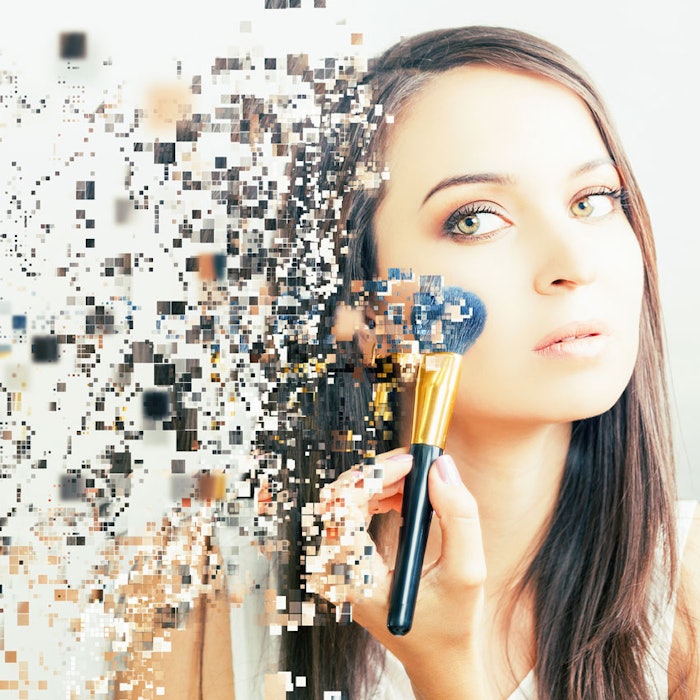
While attendees at in-cosmetics Global “photobombed” supplier selfie stations, immersed in textural experiences, traced next-gen solutions in sustainability and internalized holistic approaches to skin and hair health, education sessions surrounded the show floor with a deeper dive into several core areas. One in particular gave an overarching view of six new trends in cosmetic technology; moderating the session was Paolo Camattari, formulation technology manager, of Oriflame.
1. Circular Economy
The latest approach to sustainability that companies are embracing is recycling natural by-products and waste from food and agriculture to create active ingredients for cosmetics. Giorgio Dell’Acqua, Ph.D., a consultant and long-time proponent of this practice, gave Cosmetics & Toiletries an example. “I recently collaborated on a project to re-use the skin of blueberries from foods to protect against blue light,” he said.
Dell’Acqua explained that reducing an ingredient’s carbon footprint by improving waste management has become a necessary step in the product development cycle. Not only that, recycling natural by-products or waste from the foods industry is a sustainable option for ingredient suppliers since, once optimized for cosmetics, these naturals can have multiple applications. He gave several examples of the benefits afforded by citrus peels, which are rich in flavonoids; olive waste, which is rich in polyphenols; and tomato pulp and seed, which hold antioxidant benefits and whose fermented components can yield amino acid and prebiotics.
2. Artificial Intelligence for Ingredient Discovery
Technology is enabling the reinvention of traditional ingredients in numerous ways; from refined processing methods to impart added benefits, to in silico modeling that takes some guess work out of the discovery process. Neil Foster, of Nuritas, spoke on the latter.
According to Foster, perhaps no technology has the potential to disrupt the status quo more than Artificial Intelligence (AI), and while Hollywood paints a picture of self-aware robots destroying the human race, the reality could be much more constructive. Foster described an approach combining artificial intelligence with genomics to discover new targeted bioactive peptides from nature.
“The library of plant and animal-derived peptides has gone through hundreds of millions of years of Darwinian struggle to become potent repairers, healers and protectors with fast signaling,” observed Foster. As such, the goal was to unlock the full potential of plants based on a targeted, fast discovery process looking in places never before imagined. From this, a three-pronged approach evolved: target, predict and unlock.
To target potential peptides, AI was employed. According to Foster, the artificial brain can read 10,000 research papers per day, perfectly recalling everything it has read and seeing connections and patterns beyond what the human mind can. Together with genomics sequencing, AI can quickly predict, based on the billions of peptides out there, those with application potential for humans—as a “peptide finder.” It can then configure and unlock the potential of the peptides available and qualify that the predictions made exist in reality. It also provides a roadmap for scaling them without a loss in activity.
According to Foster, “Deep learning helps build new predictors and creates new levels of efficacy.” Furthermore, as new peptides are discovered, a massive new dataset of proprietary knowledge is created
3. Microbiomics for Cosmetics
No discussion of the latest trends in cosmetic technology would be complete without considering recent advances in microbiome research. Denis Wahler, of Givaudan Active Beauty, provided this. With the advent of metagenome and biogenetic technologies, he explained that researchers have been able to measure the importance of the skin microbiome in hygiene and personal care. From this, cosmetic scientists have focused on its crucial link to beauty and well-being. However, an important connection the industry must make is in educating the consumer.
Wahler described recent efforts by Givaudan to advance probiotics and prebiotics from gut microbiota research and promote skin benefits. “There are three main approaches to the microbiome. You can rebalance it, protect it or trigger it for given benefits.”
He explained the rebalancing aspect relates to providing prebiotics and probiotics to support the microbiome’s return to balance. Protecting it is exactly that—keeping a healthy microbiome in balance by protecting the “good” bugs and, in turn, reducing the “bad” bugs. Finally, triggering the microbiome relates to leveraging its influence on skin for desired benefits; for example, providing a precursor for skin whitening that is inactive but upon contact with the skin microbiome, is cleaved and initiates a cascade of events for the desired end results. Givaudan has designed technologies to address all three of these key approaches.
During the Q&A session, Camattari noted the different interpretations and claims made by the industry for ingredients targeting the the microbiome. He asked, “What approach do you think the industry should take? How should we set this definition?”
Wahler responded, “A probiotic claim is good because it’s known by consumers, thanks to yogurt but it’s different in skin. I think we should just say ‘protect your microflora’—which is another familiar term and an easier way to approach it.”
4. Hydrotalcites for Controlled Delivery
According to Michele Sisani of Prolabin & Tefarm S.r.l., synthetic layered double hydroxide clays (LDHs) have attracted attention due to their easily tuned chemical composition, biocompatibility and lack of toxicity. Structurally, these materials comprise positively charged layers and charge-balancing exchangeable anions located in their interlayer regions. They are currently used as carriers of drugs, amino acids and antibiotics, and show good results in terms of controlled release, drug loading and the protection of labile biomolecules.
In cosmetics, these materials serve as rheology modifiers, mattifying agents, multifunctional excipients, absorbents and texturizing agents. However, according to Sisani, “The most interesting applications in cosmetics arise when they are used as a carrier for active ingredients.”
His company has developed green synthesis methods to produce ingredients intercalated within the layered structure of LDHs with a very high loading (up to 50% w/w). Thanks to this layering, the resulting materials can be utilized in various applications. Examples given include: photoprotection, increased bioavailability, masking of bad odor or taste and modified release. For example, antiperspirants can be designed so that the more you sweat, the more actives are released.
Sisani also demonstrated how, by changing the composition if the formulation within which the materials are used, developers can modulate the release of active materials based on desired kinetics.
5. Wearables for Non-invasive Skin Research
If you ask Emer Duffy, of Dublin City University, wearables hold potential beyond health trackers and entertainment value; they have real clinical applications. According to Duffy, there is increasing interest in the development of non-invasive tools for investigating the properties of skin, as they promise non-destructive sampling, reduced ethical concerns and comparability of results in vivo and in vitro. She explored wearable samplers for profiling skin volatile species with gas chromatography-mass spectrometry analysis, as well as wearable impedance-based tattoo sensors for the assessment of the electrical properties of skin.
“We’re seeing ingestible wearables to monitor health, including contact lenses, sweat sensors and temporary tattoos to track sodium and potassium in the sweat of athletes,” said Duffy. “But I think there’s a great deal of interest and opportunity in examining our skin’s volatile emissions.” She explained they are easy to access and are appearing more often in the literature in relation to monitoring health conditions.
“We developed a platform to collect skin volatiles, which we performed in subjects and found the volatiles were made up of aldehydes, acids, ketones, esters, etc. We learned this composition can vary from males to females, according to age and based upon pathological conditions,” she said. From these results, they created a heat map of the samples from participants, which one might envision could be useful to target personalized skin care or health solutions.
Her research group also designed temporary tattoo color-change sensors that, when applied to skin, interact with the volatiles released that could be used to indicate epidermal hydration and to manage epidermal conditions. They could also be used for the efficacy testing of personal care claims, and to validate the accuracy of skin equivalents. She added, “The skin microbiome is a future area of interest.”
6. Better Aging as the New Anti-aging
Wrapping up the discussion on new trends in cosmetic technology, Andrea Mitarotonda, of Neal's Yard Remedies, explored how, for years, cosmetic scientists have focused on the ultimate anti-aging product. However, he countered, “What is the true meaning of ‘anti-aging’ Is this not a contradiction in terms?” He proposed cosmetic products should support changes with aging including emotions and stress, for a holistic approach in support of better aging instead of anti-aging. He also considered the role of the brain in the process of skin aging.
Camattari pressed, “This idea of well aging is getting a lot of attention. Is anti-aging even a credible claim anymore?”
Mitarotonda responded, “The anti-aging market is still very much on the rise. Life expectancies are lengthened but now we need to find new, better and different ways to age. We are moving … in a holistic direction and also considering food, stress and sleeping well.”
He added this is all in the vein of wellness, which is based on the three pillars of food, physical activity and social engagement. Studies have shown the effects of sleep and stress on skin. Furthermore, cosmetics are being recognized as doing more than just ameliorating skin; they enhance self-esteem, decrease stress and also can influence emotions. This is where the brain-skin connection comes into play.
“Mindfulness is another area impacting our health and well-being—but this isn’t new...our Asian friends have been doing this for centuries,” he said.
Lastly, sustainable and green chemistry principles come into play as well; but not only for their earth-friendly nature. For example, the botanical ingredient frankincense is typically distilled to its essential oil for use, leaving behind by-products. And the remaining resin gum has been re-engineered as an ingredient with anti-aging effects—but these included holistic benefits: volunteers testing it felt better. Clinical studies of their stress response, observed after 21 twice-daily applications showed increased subjective well-being and reduced stress, as measured by levels of cortisone in the saliva.
The topics described during in this conference session were but a sampling of innovation scattered throughout the show floor. But their overall tone seemed to accurately reflect a larger future direction of the industry.










